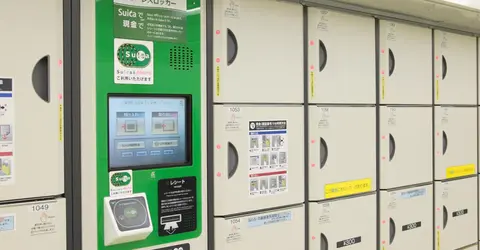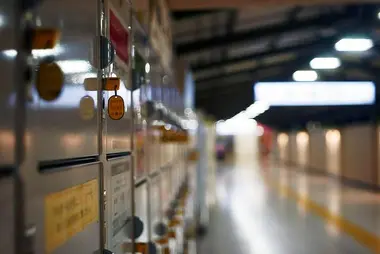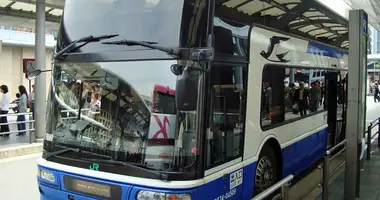Coin locker: Japanese luggage lockers

Coin lockers in Japan
Wikimedia Commons
Automatic luggage lockers, or "coin lockers" in English, are ubiquitous in Japan. These practical coin-operated lockers allow you to temporarily store your luggage in public places such as stations, airports, shopping malls and tourist sites. They are popular with travelers and locals alike, who appreciate the hands-free mobility. The coin locker system is particularly well suited to Japan, where flights are rare and trains have no luggage compartments. Let's find out all you need to know about these well-thought-out lockers!
Where to find coin lockers in Japan?
Coin lockers are truly everywhere in Japan! You'll find them in abundance in railway stations, with the biggest concentrations in Shinjuku (nearly 3,600 lockers), Tokyo, Ueno, Ikebukuro and Shibuya. But even small provincial stations are equipped with lockers. Airports, shopping malls, department stores and major tourist attractions also have numerous lockers.
The accessibility of coin lockers is excellent: they are generally available from the first to the last train, i.e. from 6 a.m. to midnight. Prices are very reasonable, ranging from 300 to 700 yen per day, depending on size. At peak times or during Golden Week, it can happen that all the lockers are taken, especially the larger ones. However, a little patience is all that's needed, as places become available on a regular basis.
Why and when use a luggage locker?
Coin lockers are indispensable on a trip to Japan in a variety of situations:
- For a day or multi-day trip from a "base camp" city, it's best to leave your larger luggage in a locker and travel light.
- For late departures or early arrivals at the airport, the luggage lockers allow you to make the most of the day without getting bogged down.
- When traveling from city to city, there's no need to carry all your luggage, just the essentials.
- To test the experience of a night in a capsule hotel, cramped by nature, the lockers are perfect for leaving most of your belongings there.
- During a shopping session, following the Japanese model, you can store your purchases in a locker corner while you continue shopping or take a break.
Whatever the reason, coin lockers come in handy when you're on the move. And thanks to their sheer number, it's easy to find one close to where you are.
Features of coin lockers: sizes and prices
Most coin lockers come in 4 sizes, with a standard depth of 57 cm. From the smallest to the largest, you'll find :
- Small (S): 34 x 34 x 57 cm - 300 to 400 yen/day
- Medium (M): 55 x 34 x 57 cm - 400 to 600 yen/day
- Large (L): 84 x 43 x 57 cm - 600 to 800 yen/day
- Extra Large (LL) : up to 177 x 57 x 57 cm - over 700 yen/day
S lockers are suitable for a small backpack or a few purchases. M or L lockers are more suitable for a carry-on suitcase. Very large LL lockers, which can accommodate large suitcases or hiking bags, are rarer and found mainly in larger stations.
Rates are calculated per 24-hour period, from midnight to midnight, and not per hour. For example, luggage left at 10 a.m. must be collected before midnight on the same day to be charged for one day. After 3 full days, the lockers are emptied by staff, so this is the maximum length of time they can be used.
How do I use a coin locker?
Coin lockers are very simple to operate. For classic models, you simply place your belongings in a free locker, insert the indicated amount in 100 yen coins into the slot, turn the key and remove it. To retrieve your luggage, simply replace the key, turn it and the door opens.
More modern lockers are managed via a central touch screen, with an English-language interface. Select a free locker on the screen, place your belongings in it and close the door. Back at the screen, you select your mode of payment: cash (coins and banknotes) or prepaid card such as Suica or Pasmo. For cash payments, the machine issues a ticket with a PIN code. To retrieve your belongings, simply type this code on the screen or scan your card.
Maximum deposit times
As a general rule, the maximum deposit time in a coin locker is 3 days, after which the lockers are opened and emptied by staff. However, you should ask locally, as this can vary from station to station, and can take up to 8 days at airports such as Narita.
For longer-term storage needs, major stations offer human-operated locker services. Kyoto station, for example, offers a maximum period of 15 days.
Other luggage storage solutions
If you can't find a free locker, or if you have bulky luggage, there are other options:
- Traditional staffed lockers at stations, airports and some hotels.
- Luggage forwarding services such as Takkyubin, to send your luggage from one city to another or from the airport to your accommodation.
- Luggage storage directly at the hotel, by asking at reception, even if you're not staying there.
Thanks to coin lockers and other luggage storage and transport solutions, traveling light in Japan is child's play. So you can concentrate on what's most important: making the most of your stay!











